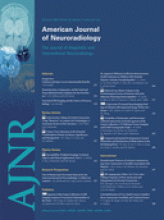Some of my recent editorials have dealt with the impact that open access (OA) has on the scientific and economic aspects of the American Journal of Neuroradiology (AJNR). As is well known, in addition to being a public service, OA allows greater dissemination of articles. In general, medical journals offer these types of access:
Subscription access—articles only available to those who pay subscription fees.
Selective (or partial) OA—selected articles, such as reviews or those funded by government monies, can be viewed immediately for free.
Delayed OA—part of or all articles can be viewed for free after a period of time, generally 1–2 years. This type of access can be combined with selective OA; AJNR offers this type of combined access.
Pay per view—anyone can view an article by paying a 1-time fee.
OA—all articles are free immediately after publication. (A complete OA model was tried by the British Medical Journal [BMJ], but some years later it was modified to protect its subscription revenue.)
An indirect and welcome effect of OA is that of increased citations that lead to a higher impact factor, thus increasing a journal's prestige. This is what is called “citation advantage,” and it has been confirmed for sciences outside of medicine.1 The citation advantage is thought by some to be related to self-selection: that is, authors who are highly citable publish in OA journals, OA articles are promoted more, editors choose prestigious articles for OA, and OA articles are found in free self-archives. All published studies concluding that OA increases impact factor have been retrospective in design.2
In July 2008, the BMJ published an article in which investigators performed a randomized prospective trial of OA.3 From 11 journals published by the American Physiologic Society, they randomly assigned 247 articles to immediate OA and used another 1372 subscription-only articles as controls (these were OA 1 year after publication). Articles from both groups were culled from a 3-month period (January to April), and data for analyses were retrieved the next January. These are some of the observations made in that important article:
OA articles had 89% more full text downloads, 42% more PDF downloads, and 23% more unique visitors.
Review articles showed increased downloads.
Articles featured in press releases or appearing on the cover of a journal had increased downloads.
Longer articles with more references, those that appear in journals with a high impact factor, and those found in self-archives had increased downloads.
Despite all of these seemingly positive effects, the most important conclusion was that OA did not result in more citation counts! Fifty-nine percent of OA articles were cited 9–12 months after publication compared with 63% of subscription-only articles. These conclusions go against our expectations and deserve some thought but are similar to those for other fields such as astrophysics.4 The first caveat that comes to mind is that the period of time after publication was too short and some citation activity was therefore missed. However, other studies have noted differences in citations just 10 months after OA publication.5 To account for the high number of downloads, articles must have been viewed (and hopefully read) by many individuals who did not cite them (the general public? communities of individuals who are not investigators?). It is also possible that investigators who are actively citing articles are those who already subscribe to journals and do not require free access to them. Although articles featured on the covers of journals receive more attention, the same cannot be said of their position in the table of contents and of the position of the table of contents in the journal; both have no effect on citations. Most readers never view a table of contents. This is because most articles are electronically accessed, and readers are taken directly to them by search engines.4
Do the results of the BMJ study negate the advantages of OA? One's initial reaction is to answer yes. This means that we should not expect OA to increase a journal's impact factor. I think that the problem is not with the OA models but rather with the impact factor. It is clear that the impact factor no longer reflects article usage and dissemination of knowledge as it did in the past. Researchers choosing to send their work to a specific journal based on its impact factor and committees awarding promotions and tenures based on impact factors are making their decisions, in my opinion, on an outdated model. Academic institutions will need to create new criteria (number of hits? number of PDF and full-text downloads and other on-line profiles?) to assess the importance of research. For example, AJNR's impact factor is 2.338, but this score does not reflect the fact that more than 3.4 million articles were downloaded from our Website last year (Fig 1). Though our impact factor increased from 2006 to 2007, this increase does not echo the 1 million additional downloads occurring during the same time period when compared with the previous year. If the on-line usage trend continues, this year we will see more than 4 million AJNR article downloads! It is obvious that the selective type of OA that AJNR uses has had a significant impact on article availability. I am not sure which OA model will work better for AJNR, or which will prevail in medical publications, but OA is here to stay and we need to embrace it.
AJNR data downloads by year.
- Copyright © American Society of Neuroradiology












